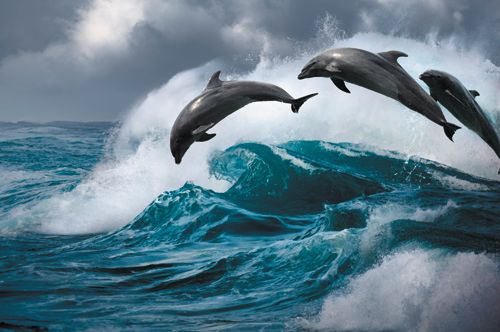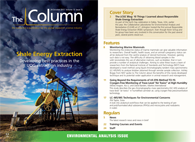Monitoring Marine Mammals
Monitoring the endocrine status of marine mammals can give valuable information to researchers. Overall health, health issues, and an animal’s pregnancy status can all be deduced from the careful analysis of steroid hormones. However, gaining such data is not easy. The difficulty of obtaining blood samples in the wild necessitates the use of alternative matrices, such as blubber, that in turn provide a number of analytical challenges. Aiming to solve these issues a team of researchers from the National Institute of Standards and Technology (NIST) have developed a novel method using liquid chromatography tandem mass spectrometry (LC–MS/MS) to analyze blubber obtained through remote sample collection. Ashley Boggs from NIST spoke to The Column about the benefits of this newly developed technique and its potential wider application in animal research and management.
Photo Credit: Willyam Bradberry/Shutterstock.com

Monitoring the endocrine status of marine mammals can give valuable information to researchers. Overall health, health issues, and an animal’s pregnancy status can all be deduced from the careful analysis of steroid hormones. However, gaining such data is not easy. The difficulty of obtaining blood samples in the wild necessitates the use of alternative matrices, such as blubber, that in turn provide a number of analytical challenges. Aiming to solve these issues a team of researchers from the National Institute of Standards and Technology (NIST) have developed a novel method using liquid chromatography tandem mass spectrometry (LC–MS/MS) to analyze blubber obtained through remote sample collection. Ashley Boggs from NIST spoke to The Column about the benefits of this newly developed technique and its potential wider application in animal research and management. - Interview by Lewis Botcherby
Q. Why is it important to profile steroid hormones in marine mammals and what insights does the data offer?
A: Steroid hormones are often studied singly or according to classes. However, these classes are separated by small changes in the structure of the steroids, and can induce multiple physiological responses beyond common interpretations. Therefore, studying the larger steroid profile allows us to uncover the interplay among the hormones, which in turn identifies better diagnostics for detecting pregnancy, sexual maturity, and stress. Marine mammals are long-lived species and often critical top predators in their ecosystems. In this manner, they can serve as sentinels meaning that they can indicate when the ecosystem is out of balance. At NIST, we are working to improve best practices for endocrine measurements, increasing confidence in the data, which in turn improves decision making by our partners.
Q. What have been the issues achieving this in the past?
A: The problems in studying wildlife endocrinology are always going to involve difficulties in collection and matrix interferences. When collecting a sample from an animal, a stress response is induced. Because the steroids are linked in a cascade, changing stress hormones inevitably changes other hormones as well. Therefore, when possible, using a remotely collected sample will provide better baseline steroid measurements. However, remotely collected samples are often matrices alternative to blood that will have their own interferences. In the case of marine mammals, blubber is often the matrix of choice because unlike blow or faeces, it has a straightforward standardization mechanism. Therefore, developing a method to simultaneously and accurately quantify hormone pathways in a blubber sample small enough to mimic a dart biopsy was a necessity for marine mammal endocrinology.
Q. Can you discuss briefly the steps involved in collecting a remote sample?
A: Our collaborators at the National Oceanic and Atmospheric Administration (NOAA) and the National Marine Mammal Foundation collect the samples using remote biopsy techniques. The sampling vessel is manoeuvred alongside the target dolphin to within 8 m or less. A dart with a biopsy punch and a float attached to the end is fired from a crossbow or modified rifle as the target dolphin surfaces. The upper flank of the dolphin, roughly below the dorsal fin, is targeted to be consistent in the location of the biopsy sample. After striking the dolphin in the flank, the dart rebounds off and is subsequently retrieved while floating at the surface. The cylindrical sample, composed of skin overlying a blubber core, is removed from the sample tip and subsampled into four pieces in the field. Skin is collected and preserved for genetics, genomics, stable isotopes, or metals while the blubber plug is split in half longitudinally and frozen in liquid nitrogen to preserve the samples for analysis of organic pollutants, fatty acids, or steroids. Thus, a single, small, remotely collected sample can be used for multiple analyses, maximizing the information collected on each animal.
Q. The method you developed to analyze the blubber uses liquid chromatography tandem mass spectrometry (LC–MS/MS), a departure from the more established ELISA methods. Why LC–MS/MS?
A: LC–MS/MS allows for better selectivity of multiple hormones through one analysis. Essentially, with ELISA, there is always a concern of unknown interferences binding with the antibody that will affect the accuracy of the measurement. This is of particular concern when working with non-model species and when dealing with a matrix other than serum or plasma. LC–MS/MS increases your confidence in quantitation compared to ELISA by having multiple identification checks including compound mass, multiple transition masses, and retention times, all of which can be confirmed with standards. LC–MS/MS also allows for the use of isotopically labelled internal standards, which greatly reduce errors from sample processing and improves the identification of compounds. Additionally, LC–MS/MS allows for the simultaneous measurement of steroid hormone profiles instead of the oneâatâaâtime approach of ELISAs where you have to have a target steroid in mind and are often limited to choosing just a few.
Q. LC–MS techniques have a known sensitivity to lipid interference. How did you overcome these issues when analyzing a lipid-rich matrix such as blubber?
A: Steroids have cholesterol backbones making them difficult to separate from other lipids. We tried gel permeation chromatography (GPC) but found that we were losing progesterone in the process. Ultimately, we used a dispersive solid-phase extraction (dSPE), which is a loose C18 powder in a vial. You add your extract, add the acetonitrile, and vortex with the C18 powder. The lipids prefer the C18 while the steroids prefer the acetonitrile. Spin it down, pull off the acetonitrile, and you have a lipid-reduced extract.
Q. How well did the method work and what benefits does it offer compared to other methods?
A: We were able to accurately quantify eight steroids from one extract of blubber only 0.4 g in size with high reproducibility of less than 14% RSD for all compounds. The major difference between our method and other MS methods is that we use matched isotopically labelled internal standards whenever possible. When working with a complex matrix, interferences are going to be a big issue, but we accounted for this problem using best practices of matched internal standards and testing for accuracy on those compounds that did not have exact matched internal standards. What we found was that surrogate standards work for some compounds, but not all, and you do not know which will work until you test the accuracy.
Q. Are there any issues with the method that require further testing to overcome?
A: Currently, the method take about 1.2 h of instrument time per sample. We would like to make the method faster and work with less material while not sacrificing quality or quantitation, which would most likely mean moving to nano-LC. We would also like to add a few key hormones, like aldosterone, which are not in the method now.
Q. Do you believe there would have to be any adjustments of the method for it to be used for other marine mammal species?
A: It is best practice to conduct accuracy testing whenever we apply the method to a different species simply because we are unsure if there are going to be different matrix interferences. However, because steroids are conserved evolutionarily among vertebrates, we are confident that the instrumental method can be used on any species, even beyond marine mammals, as long as the sample preparation and chromatography are tested for accuracy.
Q. What are you currently working on?
A: I am currently working on transferring this technology to other laboratories for application to additional matrices and different species to maximize its utility. I have worked with other laboratories training staff and students on applying this method to remotely collect dart biopsies from different species, such as humpback whales and pilot whales, as well as blood samples to improve the knowledge of what blubber hormone concentrations mean in relation to circulating hormones. We are also working on assisting the scientific community with an inter-laboratory exercise to assess their own blubber steroid measurement methods and provide better harmonization of data across the field. Our goal at NIST is to assist our stakeholders with measurement problems. I think we have addressed this well by developing a method that can determine the endocrine status of a valuable group of species that previously had many challenges in collection and quantitation to improve confidence in data used for management decisions.
Ashley Boggs is a research biologist at the National Institute of Standards and Technology (NIST). She has worked at NIST since 2013 in the Environmental Chemical Sciences group in the Chemical Sciences Division. She graduated from the University of Florida with as B.Sc. in zoology and a Ph.D. in interdisciplinary ecology with a focus on vertebrate endocrinology and endocrine disruption. Her work at NIST focuses on hormone measurement science including the development of new measurement methods and standard reference materials to improve measurement quality in human and wildlife endocrinology.
E-mail:ashley.boggs@noaa.govWebsite:www.nist.gov

Silvia Radenkovic on Building Connections in the Scientific Community
April 11th 2025In the second part of our conversation with Silvia Radenkovic, she shares insights into her involvement in scientific organizations and offers advice for young scientists looking to engage more in scientific organizations.
Regulatory Deadlines and Supply Chain Challenges Take Center Stage in Nitrosamine Discussion
April 10th 2025During an LCGC International peer exchange, Aloka Srinivasan, Mayank Bhanti, and Amber Burch discussed the regulatory deadlines and supply chain challenges that come with nitrosamine analysis.
Characterizing Plant Polysaccharides Using Size-Exclusion Chromatography
April 4th 2025With green chemistry becoming more standardized, Leena Pitkänen of Aalto University analyzed how useful size-exclusion chromatography (SEC) and asymmetric flow field-flow fractionation (AF4) could be in characterizing plant polysaccharides.












